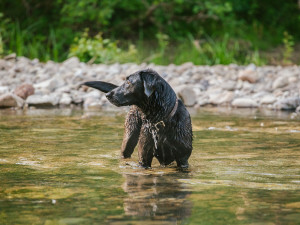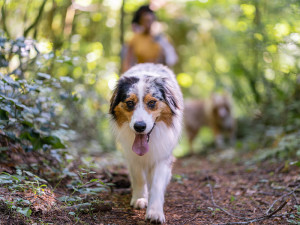Vets Issue A Warning After Two Dogs In Missouri Pass Away From Leptospirosis
The deadly disease is most common in autumn and late summer. Find out how to keep your pup safe.
The Pet Resource Center of Kansas City has issued a warningopens in new tab to pet parents after two local dogs contracted leptospirosis (aka “lepto”), a life-threatening disease that is most common during the late summer and early fall months.opens in new tab Both of the animals had to be euthanized; one was only ten months old.
Leptospirosis is a zoonotic bacterial disease, meaning it affects both humans and animals, and can readily spread from one species to another (i.e. from our dogs to us). Historically, lepto cases were most common among farmers and soldiers in tropical climates; however, outbreaks in central areas — including in NYC’s concrete jungleopens in new tab in 2009 and 2017 and LA in 2021opens in new tab — have claimed the lives of people and their pets. “When it’s nice outside like it is now, that’s when we see spikes in lepto,” Dr. Melia Washington, chief veterinarian at the Pet Resource Center of Kansas City told KJCT Newsopens in new tab.
If your dog contracts leptospirosis, the extent of care needed depends on the severity of disease, but treatment generally requires a hospital stay with pretty extensive supportive therapy. Here’s what you need to know:
What causes leptospirosis?
Leptospirosis in dogs is caused by the leptospira bacteria, which is spread through the urine of infected animals into the soil and water — most commonly rodents like rats. As dogs come in contact with a contaminated area, the bacteria can be absorbed through their skin and mucus membranes (gums, nose, eyes) or through drinking the contaminated water.
Leptospira bacteria can survive and thrive for up to 180 days given the right conditions; namely, warm, damp environments and stagnant water. That said, leptospira do need moist soils to survive, and they will rapidly die on dry surfaces. Spending time in areas densely populated with other animals (and their urine) — yep, like dog parks — increases the risk of exposure. And while wildlife such as raccoons and skunks are not affected by the disease, they serve as “innocent hosts” and can still carry and spread it to the environment.
Symptoms of leptospirosis
The clinical signs of leptospirosis in dogs can be vague and mimic those of many other diseases: fever, lethargy, loss of appetite, muscle stiffness, vomiting, and diarrhea. Jaundice — the yellowish discoloration of the gums or whites of the eyes — is typically the first sign. In severe cases, this disease moves rapidly and can turn fatal pretty quickly. In mild cases, dogs may show no symptoms at all, and the disease may even go undetected.
How is leptospirosis diagnosed?
Unfortunately, since leptospirosis in dogs often looks like other diseases, confirming an infection is generally not easily done when your pet walks into the exam room; but rather, tends to require a couple of rounds of testing if the initial blood work and urinalysis look suspicious. What raises suspicion of a leptospira infection are elevated kidney and liver values, and sometimes the white blood cell count too. If this is observed, your veterinarian will then recommend a special blood and urine test be sent out to a laboratory. Results can take several days, and so antibiotic treatment is often started prophylactically, pending the results.
Thankfully, most infections are subclinical, which means observable leptospirosis symptoms will not likely develop, nor will your pet will experience true illness. However, if your pet does develop sudden signs of the disease, and those signs appear severe, the prognosis is generally guarded (there’s a 50/50 chance of survival). Without immediate treatment, leptospirosis can lead to kidney failure, liver failure, and even death. Blood or plasma transfusions are sometimes needed if your dog’s body loses its ability to clot due to liver compromise. Yes: this is one bad bug.
How can you keep you and your dog safe?
In general, it’s important to minimize your dog’s access to areas populated by rodents and farm animals to limit the risk of exposure. When hiking with your dog, when possible, watch out for areas heavily trafficked by wildlife. Keep your yard free of stagnant water and clean your home often — especially in areas where there is pet urine. In the city, rats are kind of hard to avoid, so steer clear of puddles and don’t let your pet drink from communal water bowls at dog parks or those put out by local businesses as you don’t know how often the water is refreshed or bowl cleaned (thanks but no thanks!). If your dog attends daycare, get your pet vaccinated — more on that below.
“Cases of leptospirosis tend to spike in the late summer and fall, or, in cooler climates, during rainy winters,” says Ashley DiPrete RVT, VTSopens in new tab. “Outbreaks tend to follow seasons with abnormally high rainfall or increased flooding.” So, since we’re currently in the heart of hurricane season and NYC saw unprecedented flooding just last weekend, now’s the time to be vigilant. If you’re in SoCal and are wondering, Why are we dealing with a lepto outbreak when it never rains here?! good question. Well, the cases of leptospirosis in Los Angelesopens in new tab have been traced back to daycares and dog parks, where shared water bowls and kiddie pools are literal reservoirs for leptospirosis.
Do leptospirosis vaccines work?
Yes and no. Vaccines for leptospirosis contain what are known as “serovars,” or strains, which are components of the bacteria used to stimulate protection from disease. But, there’s a catch. There are at least nine strains that can cause the disease, yet the vaccine contains only a fraction of these, offering incomplete protection. So, pet parents often have a false sense of security that their dog is protected because they have been vaccinated, but this is not always the case.
Not to mention, immunity only lasts six to eight months, so some veterinarians recommended vaccinating high-risk dogs (such as dogs who hunt, show dogs, dogs with frequent access to still-water lakes, and those living in endemic areas) every four to six months. Talk to your veterinarian about your dog’s risk of exposure and the most common local strains found in your area. They will be able to recommend a vaccine protocol (or not) that makes sense for your dog.









